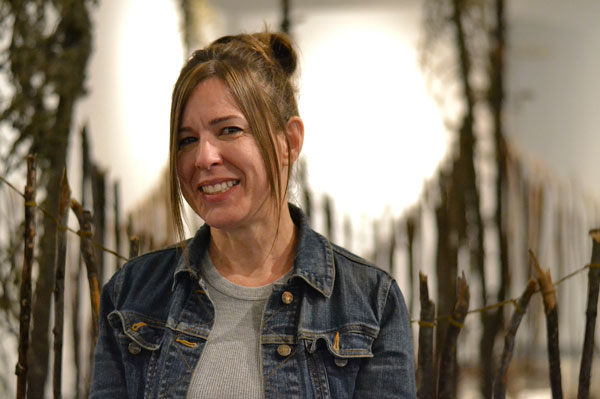
Interactive exhibit at Mann Art Gallery celebrates life off the land in northern Sask. community
The fresh smell of the forest, the sound of elders singing and fringe sticks brushing against your skin: these are elements of an upcoming exhibit at the Mann Art Gallery.
The interactive exhibit is called Patuanak: Axenet’i Tth’al, a Dene word meaning ‘fringe’ in English.
Resident artist Michèle Mackasey and guest artist Manuel Chantre are working together to give guests an experience that takes them into the First Nations community of Patuanak.
“People still live off the land quite a bit, they’re amazing hunters and trappers and fishers. They still tan their hides. The community knowledge base is incredible,” said Mackasey.
Mackasey and residents of Patuanak used trees and moss from there to build a forest in the gallery. It’s designed like a lynx trap.
“All the sudden it’s like we’re trapping our audience into our maze to experience the community,” she said.
As guests walk through the exhibit, their movement triggers audio and projections showing how they live off the land.
“One of the projections, you hear the ladies, they’re tanning a hide. They’re just scraping. And you have the background noise along the rapids. You can hear the birds,” described Mackasey. She said Chantre collected the audio and images.
Walking into the space, the smell hits you—the freshness of the trees and the moss, even a faint smell of smoked hide.
Two men from Patuanak were placing moss around the trees on Friday. They’d been setting up since Monday.
One of the men, Anton Lariviere, spoke about his family’s relationship to the land while he worked. They regularly tan hides and enjoy their smoked fish. His last name even means ‘river’ in French.
Mackasey also spoke about her experiences in Patuanak. As a non-Indigenous person, she’s been learning about the culture as an “extended member” of the community for 30 years.
She said she made sure her status Indigenous children were engaged in the community as they grew up.
She recalled her mother-in-law saying she didn’t go to school. Mackasey replied with “’You can go to university and you would never learn those things.’ It’s very specialized knowledge.”
“I remember watching them (for) the first time how many years ago, like I was with my mother-in-law and her sisters, and…they were making dried fish.” she explained. “They were (filleting) so fast.”
“Then I went to try and they just laughed at me because I was so slow compared to them.”
Axenet’i Tth’al is open to the public from August 20 to October 19. It’s in partnership with Common Weal Community Arts and funded by the Saskatchewan Arts Board and Canada Council for the Arts.
The opening reception is on September 12. Acting Director and Curator Lana Wilson said it won’t be like others you may have attended.
“It’s going to be extra special,” she said. The Saskatchewan Arts Board has a meeting in Prince Albert in September and is sponsoring the reception.
Wilson said land has really been a theme of the gallery this year. A previous exhibit by Rigmor Clarke and a current one in the secondary gallery by Judy McNaughton were also about connection to land.
She said Axenet’i Tth’al is now bringing in physical elements of a northern landscape.
“For the Mann Art Gallery to be able to partner with them and help to give them a venue, a forum, to give them a gallery to be able to present the fruits of those labours, the rich things that have been made to give them access to a wider audience and within a gallery space is absolutely within our mandate and is such an exciting thing for us.”
The exhibit was also in Wanuskewin Galleries in Saskatoon in 2017.

